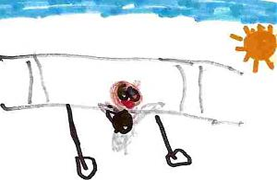
Children who have memories of past lives sometimes make drawings of their recollections, as also do some adults, although more rarely. This can be simply a way to express past-life experiences, but it can also have a therapeutic effect, helping the individual to work through past-life traumas.
James Leininger
As a small child, James Madison Leininger drew scenes that reflected his previous life as an American fighter pilot fighting the Japanese in World War II.1 His parents said he began drawing at age three, typically naval battle scenes with aircraft overhead and ‘bullets and bombs exploding all over the page’. They noticed that the details of weaponry and tactics were typical of World War II, featuring propeller-driven aircraft but not more recent technology such as jets and missiles. Further, James could name the aircraft in the pictures, mentioning Wildcats and Corsairs, and even calling the Japanese planes (identifiable by the red sun insignia) by boys’ names for the fighters and girls’ names for the bombers – the actual practice of American pilots in the Pacific theatre, as James’s father confirmed through his research. 2
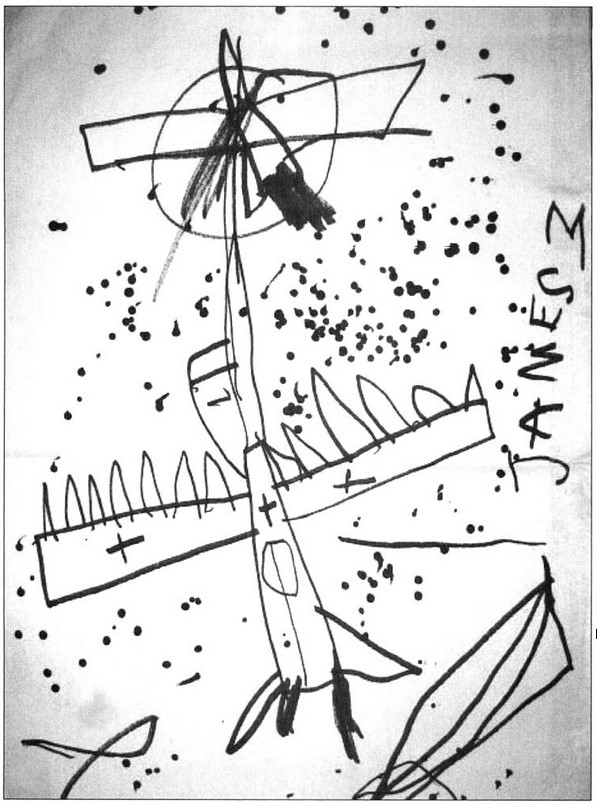
One of James’s earliest drawings, done at age three. Reproduced from Leininger & Leininger (2009).
Interestingly, James signed his drawings ‘James 3’, and when asked why, said he was ‘the third James’. By matching his memories against historical records and the memories of witnesses, the pilot he had been was identified as James Huston, Jr; thus young James apparently saw himself as the third James.3
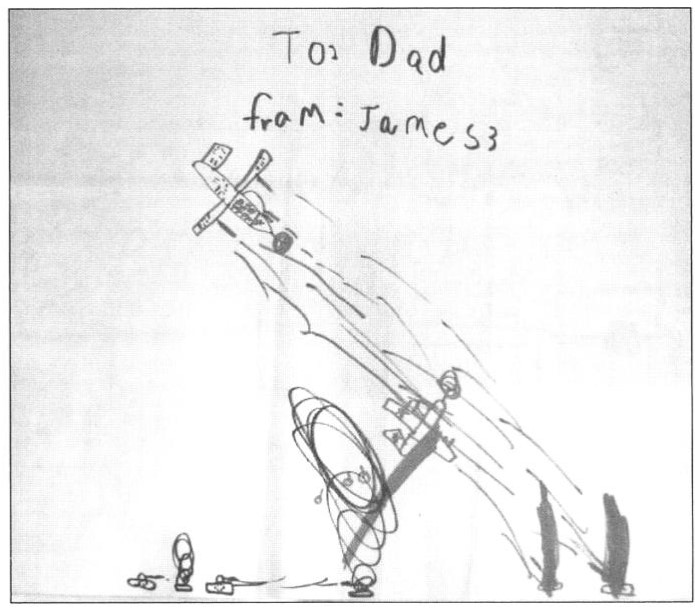
Reproduced from Leininger & Leininger (2009).
James produced hundreds of these drawings. At this time he was haunted by frequent nightmares of his previous death, plummeting into the sea in his burning plane.
Jim Tucker, child psychiatrist and successor of reincarnation researcher Ian Stevenson at the University of Virginia’s Division of Perceptual Studies, noted that such compulsive repetition is often seen in children who have suffered or witnessed a major trauma. It is technically known as ‘post-traumatic play’. Tucker, who investigated and published James’s case, writes: ‘Since the drawings occurred along with repeated nightmares about the same kind of scene, they suggest a child trying to work through a traumatic event. In James’s case, this seemed to be an event from a past life’.4
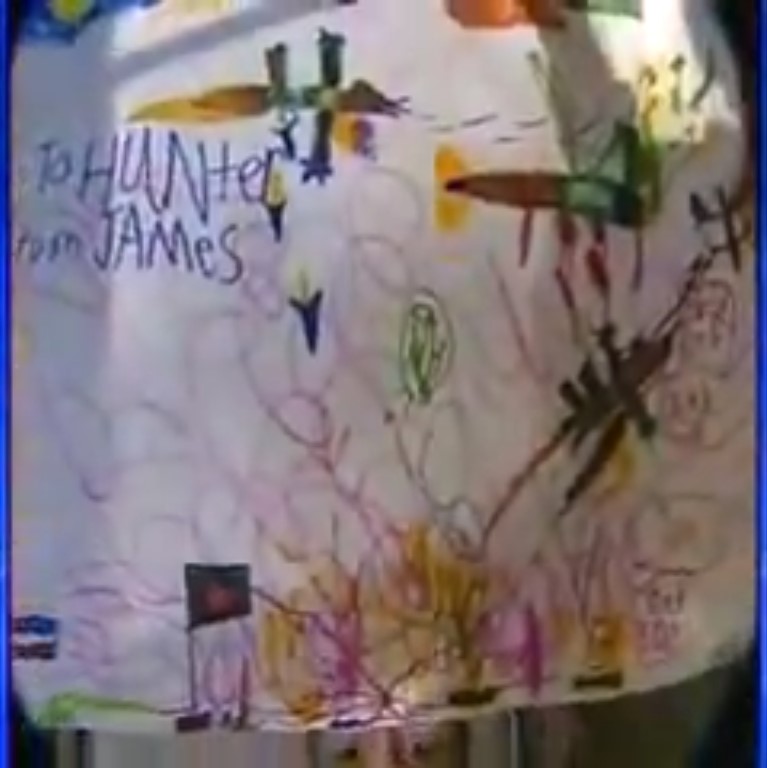
Screen-captured from Fox 8 News report.
Featured on national TV in the United States, the case drew the attention of a Japanese production company who offered to fly the family to Japan, allowing James to visit the site of his past-life death. The trip is described in Soul Survivor5 and shown on a news segment by TV reporter Suzanne Stratford of Fox 8 News that was broadcast in 2009. This report also shows several of James’s drawings with a voice-over description by his father, Bruce Leininger, as he leafs through them: ‘airplanes shooting at other airplanes or being shot down; bombing ships; you see men parachuting … planes are dropping bombs … this is a carrier.’6
At the spot in the sea where James Huston died, the Leininger family performed a memorial ceremony, with James casting a bouquet of flowers onto the waves and saying farewell to his past incarnation.7 According to his parents, he wept for more than fifteen minutes.
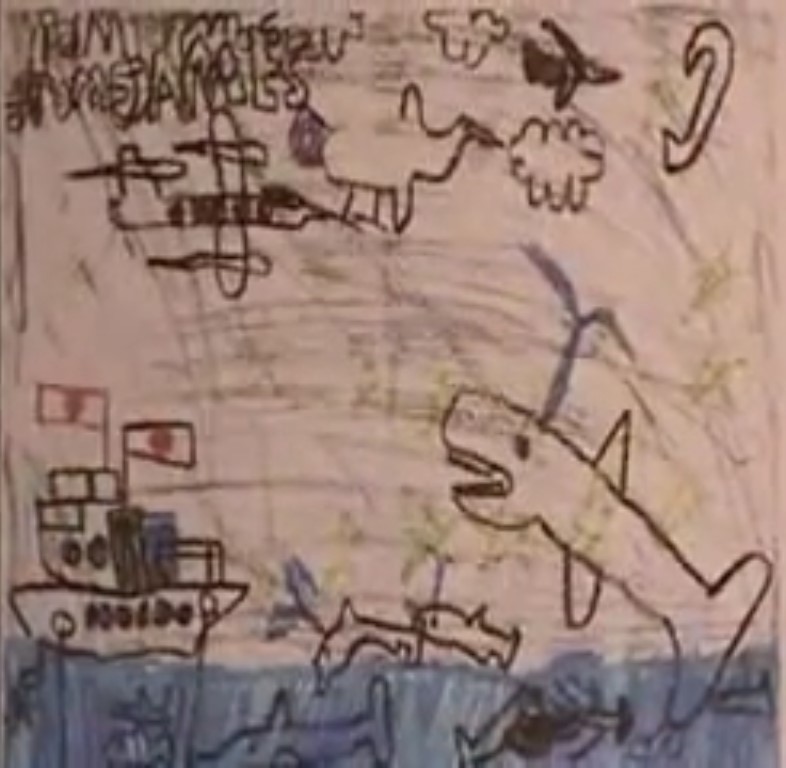
Drawn after the letting-go ceremony, screen-captured from Fox 8 News report.
Subsequently, James’s drawings relating to his past life changed in nature, becoming more positive and peaceful. One of them is shown both in Soul Survivor and the video report, and described in the book’s final paragraph: ‘There was a Japanese boat anchored in the water. The sea was filled with dolphins leaping into the air. Airplanes flew peacefully overhead. There was no more gunfire’. The ceremony had clearly had a healing effect.
Gedeon Haich
Gedeon Haich is a Hungarian who as a boy apparently remembered a past life as a dark-skinned member of a primitive tropical tribe. His case was published by Stevenson in 2003).8 The first indication of his memories came in the form of art: his mother noticed that when he drew people, he always coloured them brown, and he ignored their suggestion that he make their skins lighter. At age six or seven, he told his mother he had lived before in a different country, and when she asked where, he drew this:
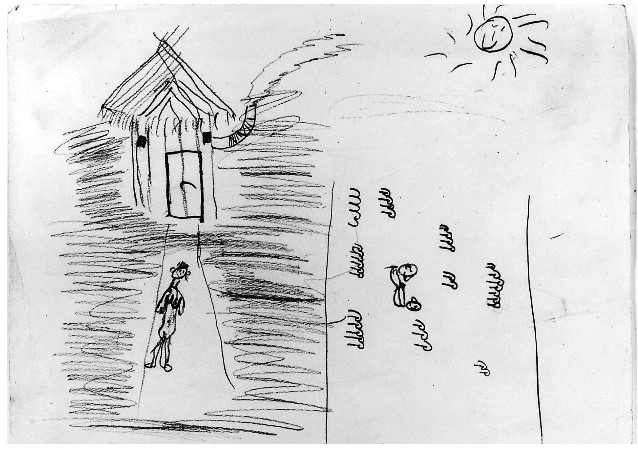
Reproduced from Stevenson (2003) Fig. 7.
His mother’s description: ‘a hut with a conical roof and a peculiar vent for the smoke, of a kind that he could never have seen in our country [Hungary]. In front of the hut he showed a naked woman with long, pendulous breasts’. The area to the right with wave motifs is a river. Gedeon identified the woman as his past-life wife, and when his mother asked him why he drew her with ‘such long, hanging ugly breasts,’ he was astonished, and said, as if it was obvious, ‘Because that is the way they were. And they are not ugly. She was very beautiful.’
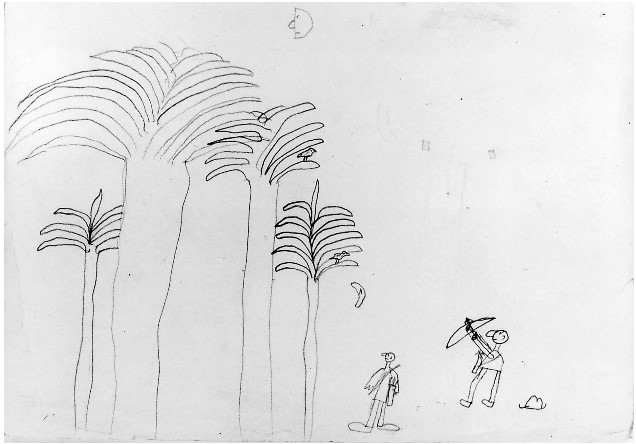
Reproduced from Stevenson (2003), Fig. 8. Night-time hunting scene with bow and boomerang. All plant life he drew was palms or other tropical plants.
Gedeon described in both words and drawings his primitive tropical life of hunting, using a dug-out canoe, and not entering rivers or lakes because there were ‘monsters’ that bit people’s legs (presumably crocodiles). He demonstrated skills in rowing, tree-climbing and drumming that he had not learned in his current life, as well as a phobia of entering open water.
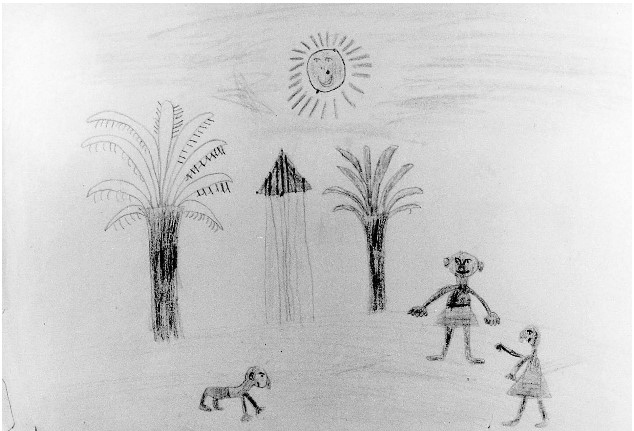
Reproduced from Stevenson (2003), Fig. 9. The original drawing was in colour and the human figures were coloured using a brown crayon.
Lack of detail, either from Gedeon or from historic records, made it impossible to identify his past incarnation. Stevenson was unable to determine with certainty what region he had lived in, though he favoured Africa, as Gedeon himself said he felt a connection to that continent; he also remembered that his people had used drumming for communication. On the other hand, his claim that he was killed by a tiger pointed to a life in India, although he may have been referring to another large cat species. He never used the word ‘boomerang’ and in fact boomering-like weapons are used in Africa as well as Australia.
Stevenson concluded that neither his sketches as a young child nor his unusual behavior could be explained by genes or the influence of his environment, alone or together.
Georg Neidhart
Stevenson published this early twentieth-century German case in the same 2003 work.9 Between the ages of five and seven, Georg Neidhart apparently had memories of several past lives jumbled together, and astounded his father by recounting his own beheading. In 1924, during a bout of depression, Neidhart, now a young man, experienced a coherent series of images that he felt was a reliving of a past life in medieval Bavaria. He recounted the sequence in writing, and included a sketch of a castle he recalled living in. He spent the next few years searching for the location and attempting to verify details, with some success.
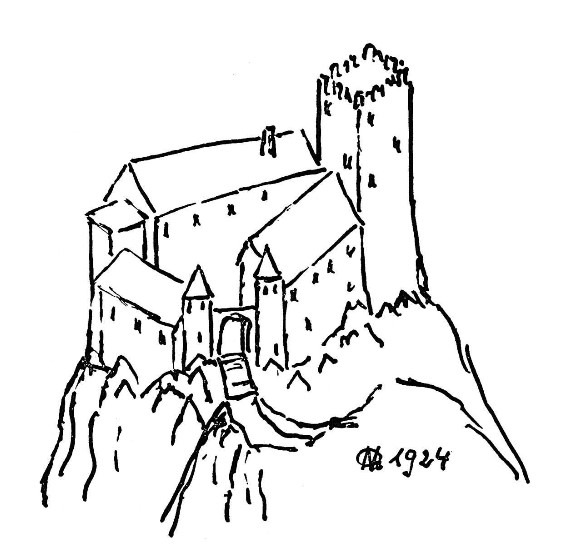
Reproduced from Stevenson (2003), Fig. 2.
By Neidhart’s own account, he began exploring the region in search of his past-life residence just weeks after his reliving experience. From the town of Regen, he set off into the Bavarian forest, following intuition alone. He writes:
Finally I came out into the open on the peak of a mountain. I was standing in front of the ruins of the once proud castle which had been erected on high, much fissured quartz rocks, standing defiantly above the surrounding region. Of the castle only the tower remained standing. It, however, had been considerably restored. By means of a somewhat unfirm wooden staircase, I climbed to the top of the tower to see the view of the surrounding area. Of the two high main buildings of the castle [seen in the vision; see Figure 2] I could only make out definitely the parts of them attached to the tower. However, from the shape of the peculiar and extremely hard rock cliffs, it was really impossible for the building complex to have had any other shape than a trapezoid one, as I had outlined it in the sketch I made at the time of having my memories.
He writes that he then discovered the remains of a secret passage he had remembered. However, neither he nor Stevenson was able to verify the names he remembered or identify his former incarnation, possible due to lack of records.
The ruins of the castle looked like this in 2001:
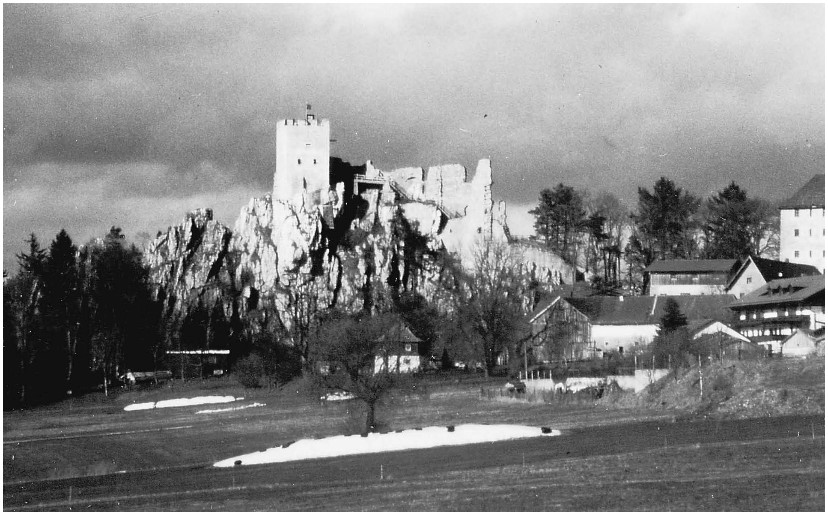
Reproduced from Stevenson (2003); photo by Daniela Meissner.
An engraving from 1726, at which time more of the main building still stood, shows that it did have the trapezoidal shape that Neidhart depicted in his drawing:
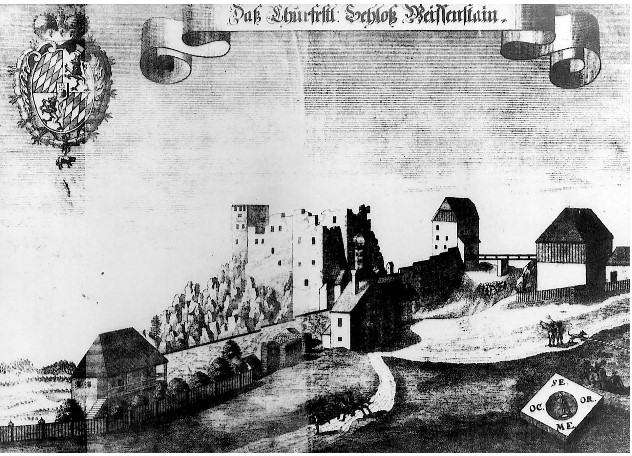
Reproduced from Stevenson (2003), Fig. 4 (provided by the Municipality of Regen).
A Japanese Girl Who Recalled an Indian Past Life
In 2012, reincarnation researcher Ohkado Masayuki published a paper on the case of a Japanese girl who recalled having been an Indian woman in her previous life.10 The girl’s memories were not sufficiently detailed for the past life to be identified. However, the names she recalled were confirmed as typically Indian by Indian associates of the author, as were details of houses she recalled. She had a birthmark on the centre of her forehead where Hindu women traditionally wear the red mark called bindi, and said herself that it corresponded to the bindi she had worn in her past life. ‘The goddess I met in heaven stamped it on me,’ she explained, ‘so that I would not forget about my life in India.’11 She also drew pictures of female figures wearing the bindi:
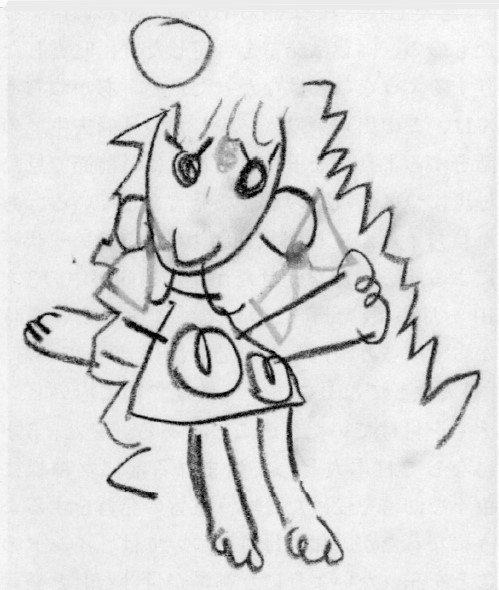
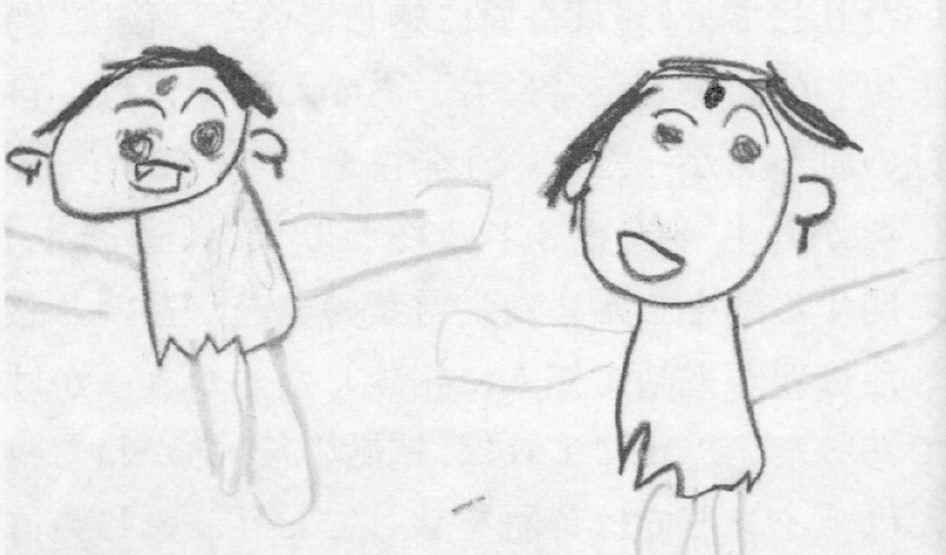
Both drawings reproduced from Ohkado (2012), 20.
Jenny Cockell’s Map
British author Jenny Cockell has described many past life recollections from multiple past lives. The most detailed was a life as an Irish woman, Mary Sutton, who died twenty years before Cockell’s birth, worried about what would become of her eight children. Cockell’s search led her to reconnect with Sutton’s children, who accepted her as their mother’s reincarnation based on knowledge she shared with them that only their mother had known.12
As a child, Cockell frequently drew maps showing the layout of the village she remembered as Mary Sutton’s home. She writes that as a child she ‘would repeatedly draw rough maps of Mary’s village, marking the shops, the main roads, the station and her home. Sometimes other remembered landmarks would appear, but there was a remarkable consistency throughout the years’.13 Later she looked at a map of Ireland to see if a particular location drew her, and found one did: Malahide, a village north of Dublin. As an adult she compared her map based on memory to a larger-scale one of the area, and found that they matched.
As an adult she drew a recreation of a typical childhood map:
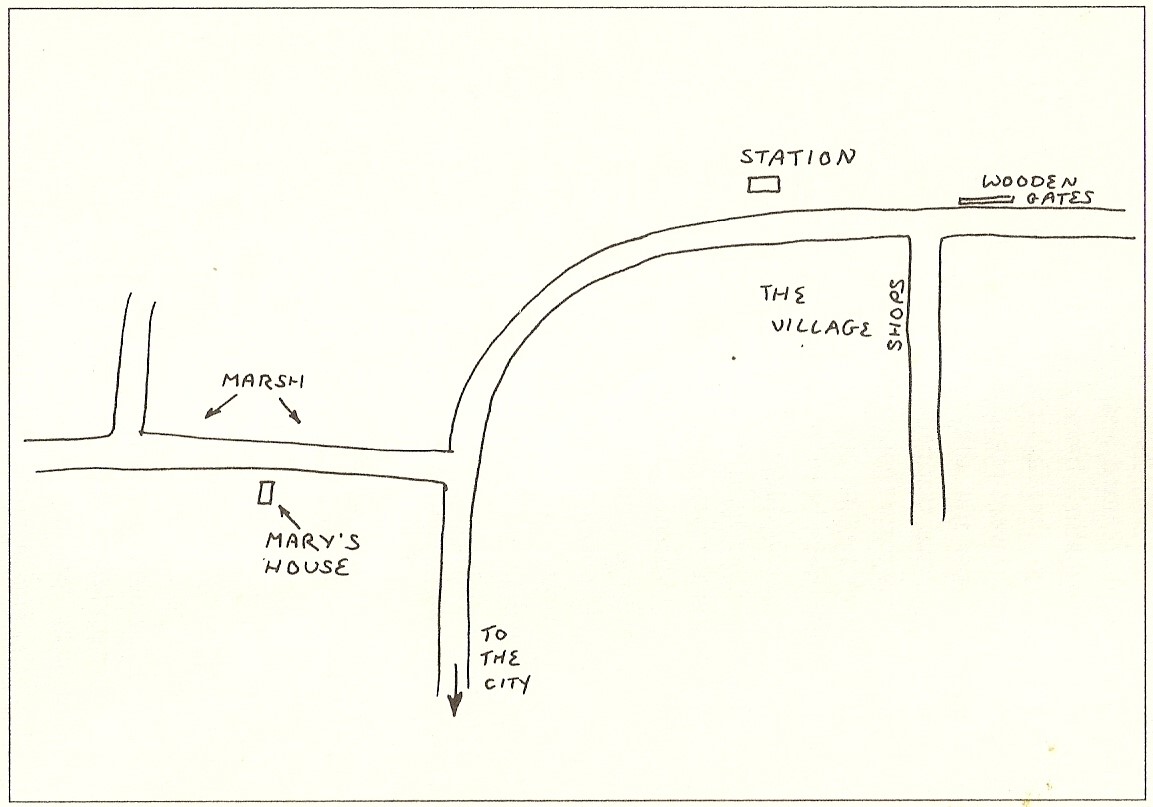
Reproduced from Cockell (1994), 7. ‘Station’ refers to a railway station.
For comparison:

Source: Google Maps
Jasmine, the Camel and the Mangle
The case of Jasmine, a young girl who appeared to have memories of World War I, was reported by her nursery school teacher writing under the username of ‘Angelcat’ on the Past Life Forum owned by regressionist and author Carol Bowman.14 Angelcat recorded her own interactions with Jasmine and other witnesses from October 2007, when the girl was age three, to December 2009. Jasmine shared many details which Angelcat or others verified as accurate, including WWI pilots’ attire, a hair product and WWI-era songs whose lyrics she knew.
Angelcat writes: ‘Despite being a very girly girl who likes playing with dolls, she often draws a biplane. She told me months ago, “Its name is camel”.’ Angelcat did not become aware until later that there was a WWI fighter biplane known as the Sopwith Camel. Angelcat posted one of Jasmine’s ‘camel’ pictures on 10 January 2008:
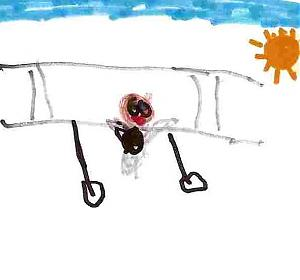
Posted here.
For comparison:
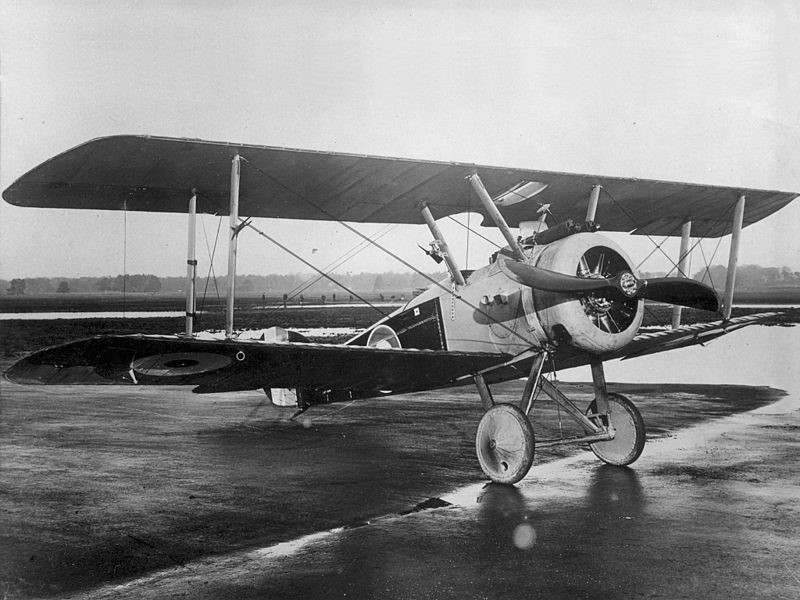
Source: Wikipedia, Sopwith Camel
In May 2009 Jasmine’s mother reported that, hearing that the washing machine had broken down, Jasmine suggested she needed a ‘mangle’. This refers to a type of hand-cranked clothes wringer that was in common use until the 1950s, but her mother did not understand what she meant. Obligingly, Jasmine drew her a picture of the machine:
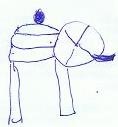
Posted here.
For comparison:
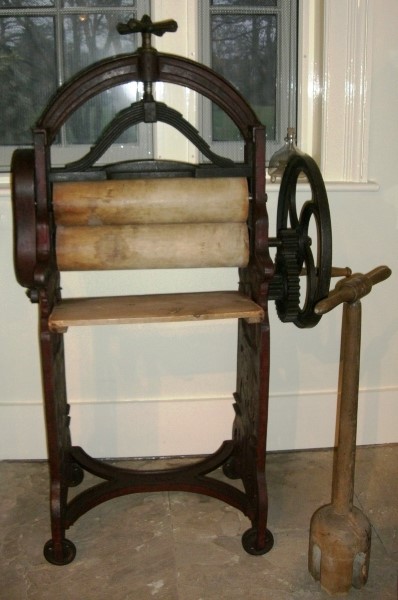
Source: National Education Network.
On 2 December 2009, Angelcat posted a picture of what appears to be a German WWI triplane, the Fokker Dr1, that Jasmine had drawn on an envelope, accompanying it with the words ‘bad bad bad’:

Posted here.
For comparison:
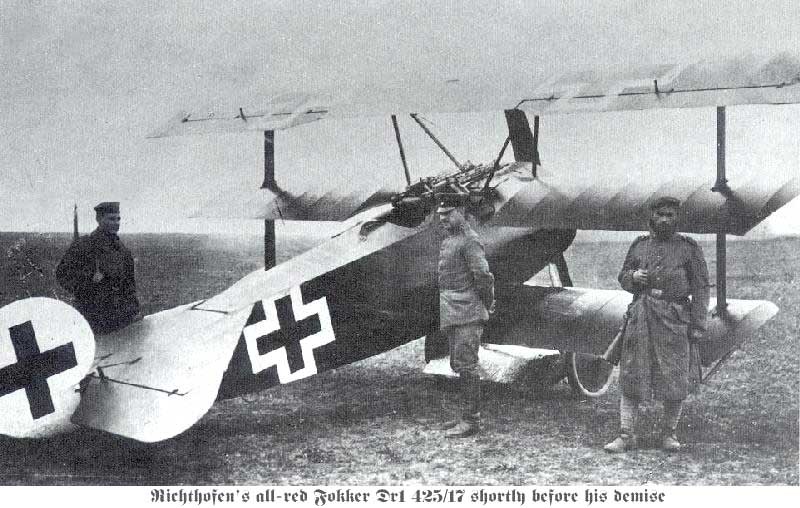
Source: Wikipedia. Note the crosses on the upper surfaces of the top wings.
Angelcat also noted that Jasmine often drew ‘what looks to me like a Zeppelin with blue and yellow streaks emitting from its rear. However, when I asked her what it was, she said, “A gas bimp”.’ Later Angelcat learned that ‘blimp’ was another word for Zeppelin, and that the exhaust that WWI German blimps emitted appeared blue and yellow (she has not posted one of these drawings).
In the thread, Angelcat claims to have identified the pilot Jasmine likely was in her past life, but declines to share the name for privacy reasons.
Other Cases
There are several other cases extant for which drawings are unfortunately not available. In 2003, Stevenson published a report of the case of Carl Edon, an English man who first began speaking of having been a German World War II pilot shot down over England at the age of two.15 As well as memories that were accurate in details, he showed behavioural signs as a child such as performing the Nazi salute, and physical signs including a birthmark that might have related to the loss of a leg in the fatal crash. He was the only fair-haired and blue-eyed person in his family, the rest having dark hair and eyes.
It was conjectured that Edon had been the pilot of a German plane whose wreckage was found in the area. However, the facts did not match to Stevenson’s satisfaction and the identification has not been made with certainty. As young as age two, Edon began sketching images from his past life, including aeroplanes, badges and insignia, including the swastika. At six, he drew the cockpit of a plane and explained what each gauge was for. He produced sketches of past-life objects for friends of the family on request. Unfortunately, his parents kept none of them.
Philosopher and reincarnation researcher Titus Rivas published a paper in 2004 which included the case of Marcel, a Dutch boy who had apparent memories of a soldier, possibly American, who had died in battle. At the age of five, according to his mother, he began repeatedly painting or drawing scenes of a beach filled with military vehicles and weapons. When she showed Rivas some of these drawings, and he agreed with her interpretation.
‘Elise’ (not her real name), the subject of a paper in submission16 by reincarnation researcher KM Wehrstein, drew many pictures as a child of corridors, chambers, doors and other features of buildings which strongly resembled those in the Nazi death camp at Auschwitz. She remembered many details of working there as a member of the Schutzstaffel (SS) who performed executions by pistol and later helped supervise the mass gassings. Because she remembered his name, it was possible to identify her former incarnation. When Elise was thirteen or fourteen, as she recalls, her parents discovered her collection of drawings and stories related to this past life, and sent her to a psychiatrist, who diagnosed severe depression and put her on medication. The collection disappeared, presumably disposed of by her parents.
KM Wehrstein
Literature
‘Angelcat’ (2007). Jasmine and her ‘camel’. [Series of forum posts, commenced 30 October.]
Leininger, A., & Leininger, B., with Gross, K. (2009). Soul Survivor: The Reincarnation of a World War II Fighter Pilot. New York: Grand Central Publishing.
Ohkado, M. (2012). Children with ‘Past-life memories’: A case of a Japanese female child with ‘memories’ as an Indian [In Japanese with abstract in English]. 人体科学 21/1, 17-25.
Stevenson, I. (2003). European Cases of the Reincarnation Type. Jefferson, North Carolina, USA: McFarland.
Rivas, T. (2004). Six cases of the reincarnation type in the Netherlands. Paranormal Review (SPR) 29, 17-20.
Tucker, J.T. (2013). Return to Life: Extraordinary Cases of Children Who Remember Past Lives. New York: St. Martins.
Tucker, J.B. (2016). The case of James Leininger: An American case of the reincarnation type. EXPLORE: The Journal of Science and Healing 12/3, 200-7.
Wehrstein, KM (in submission). An adult case with multiple past lives: Recalling Gerhard Palitzsch.
Endnotes
- 1. Tucker (2016), 201.
- 2. Leininger & Leininger (2009), 105.
- 3. Tucker (2013), 73.
- 4. Tucker (2013), 72.
- 5. Leininger and Leininger (2009), 252.
- 6. He is referring to an aircraft carrier. See 0:38-0:55.
- 7. See 3:21.
- 8. Stevenson (2003), 114-26.
- 9. Stevenson (2003), 31-42.
- 10. Ohkado (2012).
- 11. Ohkado, personal communication, 26 June 2017.
- 12. The full account is given in Cockell (1994).
- 13. Cockell (1994), 5.
- 14. Angel (2007). Thanks to Titus Rivas for directing the author to this case.
- 15. Stevenson (2003), 67-74.
- 16. Wehrstein (in submission).

